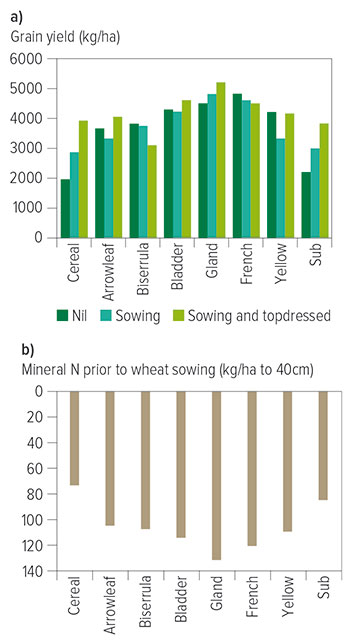Hard-seeded legume pastures are providing a step-change in sustainability, flexibility and risk management for many mixed farmers in medium to low-rainfall zones across Australia.
To further inform growers, the capacity of these comparatively new legume species to support following crop production has been under evaluation at several sites in New South Wales as part of the national Dryland Legume Pasture Systems project.
In 2019, near Ungarie, several annual legumes were grown under severe drought conditions in a replicated experiment, with wheat included as a control check treatment. In 2020, the site was sown to wheat with the plots split for nitrogen treatment.
Fertiliser nitrogen treatments were either nil, applied at sowing only (as MAP) or applied at sowing plus topdressing with urea at Zadoks growth stage (GS) 31.
Despite the severe drought in 2019, all hard-seeded legumes established well and produced a moderate amount of biomass and seed set, exceeding the performance of subterranean clover. They provided sufficient nitrogen to support wheat yields in 2020 of 3.8 tonnes per hectare, or more, without the addition of nitrogen (Figure 1).
Figure 1: (a) The grain yield of wheat (kg/ha) where no nitrogen, nitrogen at sowing only or nitrogen at sowing and at GS31 was applied in 2020 following a range of hard-seeded annual legumes, wheat or subterranean clover sown in 2019. (b) Soil mineral nitrogen prior to wheat sowing in 2020
Source: NSW DPI
Application of nitrogenat sowing or at sowing and again at GS31 did not increase the grain yield above that achieved by the nitrogen provided by the legumes alone.
In contrast, both the continuous cereal and subterranean clover treatments showed significant response to the addition of nitrogen at sowing, with a further significant increase if nitrogen was also applied again at GS31.
With the continuous cereal and subterranean clover treatments, application of nitrogen at sowing and at GS31 was required to produce an equivalent grain yield to crops that followed the hard-seeded legumes with no applied nitrogen.
Results for grain protein followed a similar pattern. Wheat grown after hard-seeded legumes achieved 12 to 14 per cent protein without addition of any nitrogen, compared with eight to nine per cent protein when wheat was grown in the continuous cereal rotation or after subterranean clover. Application of nitrogen at sowing and GS31 was required to lift grain protein to 11 per cent in the continuous cereal rotation.
System agility
Once a seedbank of hard-seeded legumes is established, pasture/crop rotations can be managed flexibly in response to seasonal conditions, commodity prices and farm logistics.
With an on-demand legume seedbank in place, growers can be flexible and change their livestock-to-crop ratios reasonably quickly.
For example, if seasonal conditions are predicted to be poor and high risk for cropping, then paddocks with a seedbank of hard-seeded legumes can be allowed to regenerate for grazing, to build soil nitrogen for subsequent crops, or both.
Alternatively, if returns from cropping are high, then paddocks can be cropped and the legume seedbank left to regenerate after the crop.
With increasing fertiliser costs, the hard-seeded legumes provide a way to reduce input costs and minimise risk by allowing a flexible switch between crop and pasture production in low to medium-rainfall environments, such as southern NSW.
This research was part of the national Dryland Legume Pasture Systems project supported by the Australian Government Department of Agriculture, Water and Environment (DAWE) Rural R&D for Profit program and the Grains Research & Development Corporation, Meat & Livestock Australia and Australian Wool Innovation.
More information: Dr Belinda Hackney, belinda.hackney@dpi.nsw.gov.au

























































